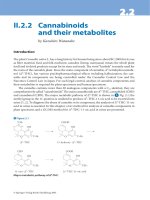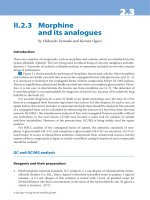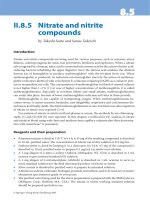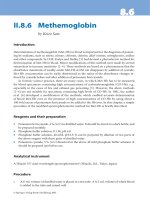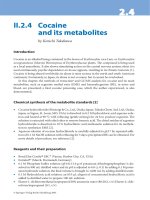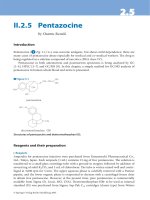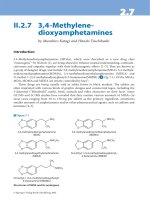Magnetism in Medicine A Handbook ppt
Bạn đang xem bản rút gọn của tài liệu. Xem và tải ngay bản đầy đủ của tài liệu tại đây (23.03 MB, 656 trang )
Magnetism in Medicine
Edited by
Wilfried Andra
¨
and
Hannes NowakMagnetism in Medicine
A Handbook
Edited by
Wilfried Andra
¨
and Hannes Nowak
Second, Completely Revised and Extended Edition
The Editors
Prof. Dr. Wilfried Andra
¨
Kernbergstrasse 39
07749 Jena
Germany
Dr. Hannes Nowak
Biomagnetic Center
Department of Neurology
Friedrich Schiller University
Erlanger Allee 101
07747 Jena
Germany
9 All books published by Wiley-VCH are carefully
produced. Nevertheless, authors, editors, and
publisher do not warrant the information
contained in these books, including this book,
to be free of errors. Readers are advised to keep
in mind that statements, data, illustrations,
procedural details or other items may
inadvertently be inaccurate.
Library of Congress Card No.: applied for
British Library Cataloguing-in-Publication Data
A catalogue record for this book is available
from the British Library.
Bibliographic information published by
the Deutsche Nationalbibliothek
The Deutsche Nationalbibliothek lists this
publication in the Deutsche National-
bibliografie; detailed bibliographic data are
available in the Internet at
8 2007 WILEY-VCH Verlag GmbH & Co.
KGaA, Weinheim
All rights reserved (including those of
translation into other languages). No part of
this book may be reproduced in any form – by
photoprinting, microfilm, or any other means –
nor transmitted or translated into a machine
language without written permission from the
publishers. Registered names, trademarks, etc.
used in this book, even when not specifically
marked as such, are not to be considered
unprotected by law.
Printed in the Federal Republic of Germany
Printed on acid-free paper
Typesetting Asco Typesetters, Hong Kong
Printing betz-druck GmbH, Darmstadt
Binding Litges & Dopf Buchbinderei GmbH,
Heppenheim
ISBN 978-3-527-40558-9
Contents
Preface XVII
List of Contributors XIX
1 Introduction 1
1.1 The History of Magnetism in Medicine 3
Urs Ha
¨
feli
1.1.1 Origins 3
1.1.2 First Medical Uses of Magnets 4
1.1.3 Use of Attracting Forces of Magnets in Medicine 5
1.1.4 Treatment of Nervous Diseases and Mesmerism 10
1.1.5 Other Medical Uses of Magnets and Magnetism 13
1.1.6 The Influence of Magnetic Fields on Man 18
References 22
1.2 Basic Physical Principles 26
Dmitri Berkov
1.2.1 Introduction 26
1.2.2 The Electromagnetic Field Concept and Maxwell Equations 27
1.2.2.1 Maxwell Equations in a General Case of Time-Dependent Fields 27
1.2.2.2 Constant (Time-Independent) Fields: Electro- and Magnetostatics 29
1.2.2.3 Electric and Magnetic Potentials: Concept of a Dipole 30
1.2.2.4 Force, Torque and Energy in Magnetic Field 35
1.2.3 Magnetic Field in Condensed Matter: General Concepts 38
1.2.3.1 Maxwell Equations in Condensed Matter: Magnetization 38
1.2.3.2 Classification of Materials According to their Magnetic Properties 40
1.2.3.3 Mean Field Theory of Ferromagnetism 42
1.2.4 Magnetic Field in Condensed Matter: Special Topics 44
1.2.4.1 Magnetic Energy Contributions 44
1.2.4.2 Magnetic Domains and Domain Walls 51
1.2.4.3 Magnetization Curves and Hysteresis Loops 53
V
1.2.4.4 Single-Domain Particles and Superparamagnetism 56
1.2.4.5 Irreversible Magnetic Relaxation 59
1.2.4.6 Reconstruction of Magnetization Distribution Inside a Body
from Magnetic Field Measurements
61
Appendix 63
References 64
1.3 Creating and Measuring Magnetic Fields 65
Wilfried Andra
¨
and Hannes Nowak
1.3.1 Introduction 65
1.3.2 The Generation of Magnetic Fields 65
1.3.3 The Measurement of Magnetic Fields 70
1.3.4 Discussion 74
References 74
1.4 Safety Aspects of Magnetic Fields 76
Ju
¨
rgen H. Bernhardt and Gunnar Brix
1.4.1 Introduction 76
1.4.2 Risk Evaluation and Guidance on Protection 76
1.4.2.1 Evaluation Process 77
1.4.2.2 Development of Guidance on Protection 77
1.4.3 Static and Extremely Slowly Time-Varying Magnetic Fields 78
1.4.3.1 Interaction Mechanisms and Biological Bases for Limiting
Exposure
78
1.4.3.2 Epidemiology 80
1.4.3.3 Safety Aspects and Exposure Levels 81
1.4.4 Time-Varying Magnetic Fields 81
1.4.4.1 Interaction Mechanisms and Biological Bases for Limiting
Exposure
81
1.4.4.2 Epidemiology 83
1.4.4.3 Safety Aspects and Exposure Levels 84
1.4.5 Electromagnetic Fields 84
1.4.5.1 Interaction Mechanisms and Biological Bases for Limiting
Exposure
84
1.4.5.2 Epidemiology 88
1.4.5.3 Safety Aspects and Exposure Limits 89
1.4.6 Protection of Patients and Volunteers Undergoing MR
Procedures
89
1.4.6.1 Static Magnetic Fields 90
1.4.6.2 Time-Varying Magnetic Gradient Fields 90
1.4.6.3 Radiofrequency Electromagnetic Fields 91
1.4.6.4 Contraindications 93
References 94
VI
Contents
2 Biomagnetism 97
2.1 Introduction 99
Hannes Nowak
2.2 Biomagnetic Instrumentation
101
Hannes Nowak
2.2.1 History 101
2.2.2 Biomagnetic Fields 102
2.2.3 SQUID Sensor 104
2.2.4 Shielding: Magnetically and Electrically Shielded Rooms 109
2.2.5 Gradiometers 113
2.2.6 Dewar/Cryostat 116
2.2.7 Commercial Biomagnetic Measurement Devices 117
2.2.7.1 4-D Neuroimaging 118
2.2.7.2 VSM MedTech Ltd. 126
2.2.7.3 Elekta Neuromag3 132
2.2.7.4 Advanced Technologies Biomagnetics (AtB) s.r.l. 139
2.2.7.5 CardioMag Imaging
TM
142
2.2.7.6 Tristan Technologies, Inc. 144
2.2.7.7 Philips Research, Hamburg 146
2.2.8 Special Biomagnetic Measurement Devices 148
2.2.8.1 Micro-SQUID Systems 148
2.2.8.2 The Jena 16-Channel Micro-SQUID Device 149
2.2.8.3 Planar Gradiometers 149
2.2.8.4 Japanese 256-Channel Device (SSL-Project) 151
2.2.8.5 Vector-Magnetometers 151
2.2.8.6 Biomagnetic Devices with Cryocooler 152
2.2.9 High-Temperature Superconductivity 152
2.2.10 Perspectives 154
References 155
2.3 Cardiomagnetism 164
Gerhard Stroink, Birgit Hailer, and Peter Van Leeuwen
2.3.1 Introduction 164
2.3.1.1 Historical Background 164
2.3.1.2 Electrophysiology 165
2.3.2 Forward Solutions 167
2.3.2.1 Introduction 167
2.3.2.2 Single Current Dipole in an Infinite Homogeneous Conductive
Medium
167
2.3.2.3 Current Dipole in a Realistic Torso 170
2.3.2.4 Extended Source Models 172
2.3.2.5 Summary 175
Contents
VII
2.3.3 Inverse Solutions 175
2.3.3.1 Introduction 175
2.3.3.2 Model Data Using the Current Dipole as Source Model 176
2.3.3.3 Model Data Using Distributed Sources as Source Model:
Imaging
178
2.3.3.4 Summary 179
2.3.4 Validation 180
2.3.5 Clinical Applications of Magnetocardiography 183
2.3.6 Ischemic Heart Disease 183
2.3.6.1 Analysis of MCG Signal Morphology 184
2.3.6.2 Determination of Time Intervals 185
2.3.6.3 Parameters of the Magnetic Field 186
2.3.6.4 Source Parameters 189
2.3.6.5 Conclusion 191
2.3.7 Hypertensive Cardiovascular Disease 191
2.3.7.1 Conclusion 193
2.3.8 Cardiomyopathy 193
2.3.8.1 Conclusion 194
2.3.9 Cardiac Arrhythmias 194
2.3.9.1 Atrial Arrhythmias 195
2.3.9.2 Ventricular Pre-Excitation 196
2.3.9.3 Ventricular Arrhythmias 197
2.3.9.4 Risk Stratification for Malignant Arrhythmias After MI 198
2.3.9.5 Conclusion 200
2.3.10 Clinical Conclusions 200
References 201
2.4 Neuromagnetism 210
Thomas R. Kno
¨
sche, Nobukazu Nakasato, Michael Eiselt,
and Jens Haueisen
2.4.1 Introduction 210
2.4.2 The Generation of Magnetic Signals by the Brain 211
2.4.2.1 Introduction 211
2.4.2.2 Technical Development and Limits of Detection 211
2.4.2.3 Electrophysiology of Brain Cells 212
2.4.2.4 Extracellular Space 215
2.4.2.5 Pathophysiology 216
2.4.2.6 Final Remarks 217
2.4.3 Analysis of Neuromagnetic Fields 218
2.4.3.1 Signal Analysis 218
2.4.3.2 Modeling and Source Reconstruction 222
2.4.4 The Investigation of the Primary Sensory and Motor Systems 230
2.4.4.1 Introduction 230
2.4.4.2 Somatosensory System 230
VIII
Contents
2.4.4.3 Auditory System 232
2.4.4.4 Visual System 232
2.4.4.5 Olfactory and Gustatory System 234
2.4.4.6 Motor System 235
2.4.4.7 Perspectives 235
2.4.5 Neuromagnetic Fields and Brain Science: Cognitive Functions 235
2.4.5.1 Brain Correlates of Cognition: Components and Localizations 237
2.4.5.2 Human Communication 238
2.4.5.3 Recognition of Objects: Perceptual Binding 241
2.4.5.4 Actions: Planning, Execution, Perception, and Imagery 242
2.4.5.5 Attention 242
2.4.5.6 Memory 243
2.4.5.7 Emotions 244
2.4.6 Clinical Applications 244
2.4.6.1 Introduction 244
2.4.6.2 Somatosensory Evoked Fields (SEFs) 244
2.4.6.3 Auditory Evoked Fields (AEFs) 247
2.4.6.4 Visually Evoked Magnetic Fields (VEFs) 249
2.4.6.5 Language-Related Fields (LRFs) 251
2.4.6.6 Spontaneous Brain Activity in Epilepsy 251
2.4.6.7 Spontaneous Brain Activity in Structural Brain Lesions and
Ischemia
255
2.4.6.8 Perspectives 256
References 256
2.5 Fetal Magnetography 268
Uwe Schneider and Ekkehard Schleussner
2.5.1 Fetal Magnetocardiography 268
2.5.1.1 General 268
2.5.1.2 Fetal Cardiac Physiology 268
2.5.1.3 Methodical Approaches 269
2.5.1.4 Standards and International Reference Values 273
2.5.1.5 Monitoring Fetal Cardiac Function: A Brief Comparison of
Methods
274
2.5.1.6 Complementary Role in Clinical Diagnosis 274
2.5.1.7 Clinical Research 276
2.5.1.8 Perspectives 277
2.5.2 Fetal Magnetoencephalography 279
2.5.2.1 General Aspects 279
2.5.2.2 Development of Senses 281
2.5.2.3 Applications of fMEG 282
2.5.2.4 Developmental Aspects of Fetal Evoked Responses 283
2.5.2.5 Perspectives 285
References 286
Contents
IX
3 Magnetic Resonance 291
3.1 Introduction 293
Werner A. Kaiser
3.2 Physical Principles and Technology of Magnetic Resonance Imaging
297
Arnulf Oppelt
3.2.1 Historical Overview 297
3.2.2 Basic Physical Principles of NMR 298
3.2.3 The NMR Signal 301
3.2.4 Nuclear Relaxation 306
3.2.5 Signal-to-Noise Ratio 309
3.2.6 Magnetic Resonance Imaging 311
3.2.7 Selective Excitation 314
3.2.8 Partial Acquisition Techniques 317
3.2.9 Pulse Sequence and Contrast 318
3.2.10 Imaging of Flow 324
3.2.11 Diffusion Imaging 326
3.2.12 MR Spectroscopy 327
3.2.13 System Design Considerations 329
3.2.14 Magnets 331
3.2.15 Shimming 334
3.2.16 Gradient System 335
3.2.17 RF-System 336
3.2.18 Conclusions 339
References 340
3.3 Modern Applications of MRI in Medical Sciences 343
3.3.1 New MRI Techniques for Cardiovascular Imaging 343
Debiao Li and Andrew C. Larson
3.3.1.1 Introduction 343
3.3.1.2 Cardiovascular Morphology 343
3.3.1.3 Cardiac Function and Flow 344
3.3.1.4 Perfusion 349
3.3.1.5 Delayed-Enhancement Imaging 351
3.3.1.6 Coronary MR Angiography 352
3.3.1.7 Coronary Artery Wall Imaging 357
References 359
3.3.2 Functional Magnetic Resonance Imaging (fMRI) 362
Oliver Speck, Axel Schreiber, Clemens Janz, and Ju
¨
rgen Hennig
3.3.2.1 Physiological and Physical Basis 362
3.3.2.2 Methods for fMRI 363
3.3.2.3 The fMRI Experiment 364
X
Contents
3.3.2.4 Data Analysis 365
3.3.2.5 Current Results in fMRI 368
3.3.2.6 Perspectives 374
References 374
3.3.3 New MRI Techniques for the Detection of Acute Cerebral Ischemia 378
Michael E. Moseley, Roland Bammer, and Joachim Ro
¨
ther
3.3.3.1 Introduction 378
3.3.3.2 Evolution of DWI Changes in Stroke 379
3.3.3.3 DWI in Clinical Practice 381
3.3.3.4 Improvements and Pulse Sequences for DWI and DTI 383
3.3.3.5 Functional DWI in Brain Mapping 392
3.3.3.6 Conclusion and Future Outlook 393
References 393
3.3.4 Clinical Applications at Ultrahigh Fields 398
Petra Schmalbrock and Donald W. Chakeres
3.3.4.1 Potential and Challenges with Ultrahigh Field MRI 398
3.3.4.2 Image Characteristics in Normal Brain 402
3.3.4.3 Applications for Neuropathology 406
3.3.4.4 Conclusion and Outlook 410
References 411
3.3.5 Interventional Magnetic Resonance Imaging: Concepts, Systems,
and Applications
416
Clifford R. Weiss and Jonathan S. Lewin
3.3.5.1 Introduction 416
3.3.5.2 Imaging System Development 417
3.3.5.3 Supplemental Technical Developments 420
3.3.5.4 Specific Applications 423
3.3.5.5 Conclusions and Outlook 433
References 434
3.3.6 New Approaches in Diagnostic and Therapeutic MR
Mammography
437
Werner A. Kaiser, Stefan O.R. Pfleiderer, Karl-Heinz Herrmann,
and Ju
¨
rgen R. Reichenbach
3.3.6.1 Introduction 437
3.3.6.2 Diagnostic MR Mammography 438
3.3.6.3 Current Limits and Disadvantages 441
3.3.6.4 New Approaches to Diagnostic MR Mammography 442
3.3.6.5 Minimally Invasive Procedures: Biopsy and Therapy 445
3.3.6.6 MRI-Guided Percutaneous Minimally Invasive Therapy of Breast
Lesions
447
Contents
XI
3.3.6.7 New Perspectives 449
3.3.6.8 Conclusion 450
References 451
3.3.7 MR Spectroscopy 456
Peter Bachert
3.3.7.1 Introduction 456
3.3.7.2 High-Resolution Nuclear Magnetic Resonance Spectroscopy
In Vivo
456
3.3.7.3 Metabolic Information and Clinical Application: In-Vivo
1
H MRS 460
3.3.7.4 Metabolic Information and Clinical Application: In-Vivo
13
C MRS 469
3.3.7.5 Metabolic Information and Clinical Application: In-Vivo
19
F MRS 469
3.3.7.6 Metabolic Information and Clinical Application: In-Vivo
31
P MRS 471
3.3.7.7 Application of MRS in Diagnostics and Clinical Research:
Conclusions and Perspectives
472
References 474
4 Magnetic Substances and Externally Applied Fields 477
4.1 Introduction 479
Wilfried Andra
¨
References 480
4.2 Magnetic Monitoring as a Diagnostic Method for Investigating Motility
in the Human Digestive System
481
Hendryk Richert, Olaf Kosch, and Peter Go
¨
rnert
4.2.1 Introduction 481
4.2.2 Conventional Investigation Methods of the Human GI Tract 482
4.2.3 Magnetic Markers 483
4.2.3.1 Inverse Monitoring 484
4.2.3.2 Theoretical Background 484
4.2.3.3 Forward Monitoring 485
4.2.4 Magnetic Monitoring Systems 486
4.2.4.1 Magnetic Monitoring with Three Magnetic Sensors 486
4.2.4.2 Magnetic Marker Monitoring Using Biomagnetic SQUID Measurement
System
487
4.2.4.3 Magnetic Monitoring with Multiple AMR-Sensors 488
4.2.4.4 Comparison of the Measuring Methods 489
4.2.4.5 Information Content of Magnetic Monitoring Investigations 490
4.2.4.6 Motility Pattern of the GI System 491
4.2.4.7 Absorption Processes Inside the GI Tract 493
4.2.5 Conclusion and Outlook 494
References 496
XII
Contents
4.3 Remote-Controlled Drug Delivery in the Gastrointestinal Tract 499
Wilfried Andra
¨
and Christoph Werner
4.3.1 Introduction 499
4.3.2 Physical Principles Used or Proposed for Remote Controlled
Release
500
4.3.2.1 Capsules Designed for Drug Release under the Guiding or Withholding
Influence of a Magnetic Field
500
4.3.2.2 Capsules Using Mechanical Forces of Magnetic Fields to Open a
Container
501
4.3.2.3 Capsule Operation Triggered by an Alternating (AC) Magnetic
Field
501
4.3.2.4 Application of Rotating Magnetic Fields 503
4.3.3 Discussion and Outlook 504
4.3.3.1 Capsules already Used for Animal and Human Studies 504
4.3.3.2 Outlook 507
References 508
4.4 Magnetic Stimulation 511
Shoogo Ueno and Minoru Fujiki
4.4.1 Introduction 511
4.4.2 History 511
4.4.2.1 History of Magnetic Stimulation 511
4.4.2.2 The Beginnings of Magnetic Brain Stimulation 512
4.4.3 Principle of Transcranial Magnetic Stimulation 513
4.4.3.1 Vectorial and Localized Magnetic Stimulation: A Computer Simulation
Study
513
4.4.3.2 Physiological Principle 516
4.4.3.3 Functional Mapping of the Human Motor Cortex 517
4.4.3.4 Inhibition–Excitation Balance 520
4.4.4 Clinical and Preclinical Application of TMS 521
4.4.4.1 Targeting Method 521
4.4.4.2 Representative Neurosurgical Case 522
4.4.4.3 Cellular–Molecular Level 523
References 525
4.5 Liver Iron Susceptometry 529
Roland Fischer and David E. Farrell
4.5.1 Introduction 529
4.5.2 Iron Metabolism and Iron Overload 529
4.5.3 Technical Developments of Biomagnetic Liver Susceptometry 531
4.5.3.1 DC-Field Low-T
C
SQUID Biosusceptometer 531
4.5.3.2 AC-Field SQUID Biosusceptometer 532
4.5.3.3 Room-Temperature Biosusceptometer 534
4.5.3.4 High-T
C
Biosusceptometer 534
Contents
XIII
4.5.4 Physical and Biochemical Basics 535
4.5.5 Magnetostatic Principles 537
4.5.6 Calibration and Validation 538
4.5.7 Magnetic Background and Noise Problems 540
4.5.8 Alternative Methods 541
4.5.9 Medical Applications 542
4.5.9.1 Measurement Procedures 542
4.5.9.2 Primary Hemochromatosis 542
4.5.9.3 Iron-Deficiency Anemia 543
4.5.9.4 Secondary Hemochromatosis 543
4.5.9.5 Long-Term Iron Chelation 543
4.5.9.6 Future Applications 544
4.5.10 Summary and Outlook 544
References 545
4.6 Magnetic Hyperthermia and Thermoablation 550
Rudolf Hergt and Wilfried Andra
¨
4.6.1 Introduction 550
4.6.2 Physical Principles of Magnetic Particle Heating 551
4.6.2.1 Losses during Magnetization Reversal within the Particles 552
4.6.2.2 Losses Caused by Rotational Motion of Particles 554
4.6.2.3 Thermal Relaxation Effects in Magnetic Nanoparticles 555
4.6.2.4 Eddy Current Effects 558
4.6.3 Physical-Technical Implementation of the Therapy 559
4.6.3.1 Demand of Specific Heating Power 559
4.6.3.2 Parameters of the Alternating Magnetic Field 561
4.6.3.3 Optimization of the Magnetic Material 561
4.6.4 Biomedical Status of Magnetic Particle Hyperthermia 564
4.6.4.1 Studies with Animals and Cell Cultures 564
4.6.4.2 Application to Human Patients 565
References 567
4.7 Magnetic Cell Separation for Research and Clinical Applications 571
Michael Apel, Uwe A.O. Heinlein, Stefan Miltenyi, Ju
¨
rgen Schmitz,
and John D.M. Campbell
4.7.1 Introduction 571
4.7.2 MACS4 Technology 572
4.7.2.1 The Concept 572
4.7.2.2 Magnetic Separation Strategies 572
4.7.2.3 Magnetic Labeling Strategies and Reagents 574
4.7.2.4 Superparamagnetic MicroBeads 575
4.7.2.5 Column Technology and Research Separators 576
4.7.2.6 CliniMACS4 Plus Instrument, and Accessories 577
XIV
Contents
4.7.3 Magnetic Cell Sorting for Clinical Applications 580
4.7.3.1 Stem Cell Enrichment for Graft Engineering in Hematological
Disorders
580
4.7.3.2 NK Cells: CD56 and CD3 583
4.7.3.3 T-Cell Subset Graft Engineering Strategies 583
4.7.3.4 Antigen-Specific T Cells: Cytokine Capture System 585
4.7.3.5 Dendritic Cells (DC): CD14-derived DC, BDCA-1, BDCA-4 586
4.7.3.6 Into the Future: Cardiac Regeneration Using CD133
þ
Stem Cells 589
References 591
4.8 Magnetic Drug Targeting 596
Christoph Alexiou and Roland Jurgons
4.8.1 Background and History of Magnetic Drug Targeting 596
4.8.2 Regional Chemotherapies for Cancer Treatment 598
4.8.3 Current Applications of Magnetic Drug Targeting 599
4.8.3.1 In-Vitro Studies 600
4.8.3.2 In-Vivo Studies 600
4.8.4 Outlook 602
References 602
4.9 New Fields of Application 606
Wilfried Andra
¨
and Urs Ha
¨
feli
4.9.1 Introduction 606
4.9.2 Magnetic Particle Imaging (MPI) 606
4.9.3 Magnetically Modulated Optical Nanoprobes 608
4.9.4 Magnetic Guidance 608
4.9.4.1 Small Particles Guided by Extracorporeally Generated Field
Gradients
609
4.9.4.2 Field Gradients Generated by Magnetic Implants 610
4.9.4.3 Magnetic Devices Moved by Alternating or Rotating Magnetic
Fields
610
References 611
5 Conclusions and Perspectives 613
Jens Haueisen
Index
617
Contents
XV
Preface
Magnetism often has a slight overtone of being mysterious. This is probably
caused by the surprisingly strong forces between magnets which everybody can ex-
perience with magnetic toys, magnet boards, or similar objects. A strange effect is
the unique ability of magnetic fields to penetrate many substances without any at-
tenuation. Though the physical basis of magnetism is well explored, the outsider
usually does not know very much about the details and sometimes tends to over-
estimate the real possibilities provided by magnetism. Nevertheless, the limits of
applications have not yet been reached. Considerable progress has taken place in
medicine during recent years, and there is no reason to assume that this develop-
ment has already come to an end.
Progress in medicine has often been initiated by the discoveries and results of
research studies conducted among the various disciplines of natural science. One
of the most famous examples to date is the discovery of a certain type of electro-
magnetic radiation, the X-ray, by Wilhelm Conrad Ro
¨
ntgen in 1895. In this case,
the importance of the discovery with respect to medical applications was recog-
nized immediately. Development was started and propelled by fruitful cooperation
between both physicians and physicists. This teamwork is still very strong, and has
led recently to the introduction of what is called electron beam tomography (EBT).
In other cases – for example, that of nuclear magnetic resonance – the time taken
between its discovery and subsequent application in medicine was longer. Some-
times, a new method has become established in clinical practice only after having
passed through a long period of in-vitro investigations and preclinical trials. How-
ever, there are applications – for example, in biomagnetism – which could not be
developed before other crucial parts (in this case the superconducting quantum in-
terference device, SQUID, as a sensitive magnetic field detector) had been invented
and further developed.
This cooperation between physicians, scientists, and engineers has proved itself
in the past to be effective. It is a necessary condition for the continuing develop-
ment of new methods or more sophisticated techniques and instruments. This is
of particular relevance for the application of magnetism in medicine. Knowledge in
this field is comparatively poor, even in the case of physicists. Specialists working
in different fields of science and technology are, as a rule, not familiar with rele-
vant problems in medicine, and as a consequence possible new ideas or solutions
XVII
to problems cannot be found until partners from different fields have been intro-
duced to the physical and medical basis of this interdisciplinary topic.
One fundamental intention of this book is, therefore, to impart information
about both the state of the art as well as the need for further progress with magne-
tism in medicine. This can only be done, within the ambit of this book, by means
of reference to typical examples. A complete review of all existing contributions in
this field would result in an edition of several volumes. We hope that the examples
presented are suitable both for initiating cooperation between specialists already
working on specific topics, and to encourage a response from newcomers who
might contribute original ideas. In our opinion, the successful development of im-
portant methods such as functional magnetic resonance imaging (fMRI) and mag-
netic source imaging (MSI) in recent years is proof enough of the fact that even
high-level technologies, which are already in existence, can be essentially improved
and expanded as soon as interdisciplinary teams are involved. Moreover, there are
also topics for which a level of knowledge has not yet been attained that would en-
able a ‘‘chain reaction’’ to start and thus accelerate further development. Here, in
the language of physicists, a ‘‘critical mass’’ of interdisciplinary cooperating spe-
cialists has probably not been achieved.
During the years since the first edition of this book was published, many new
developments have been made in the areas of medical research and clinical
practice. Therefore, all contributions to the Second Edition have been updated,
with most articles having been completely rewritten. Several new topics have been
added, including: safety aspects of magnetic fields; fetal magnetography; new MRI
techniques for cardiovascular imaging; clinical applications at ultra-high fields;
interventional magnetic resonance imaging; concepts, systems, applications and
new approaches in diagnostic and therapeutic MR mammography ; monitoring of
magnetic markers; remote-controlled drug delivery; and magnetic drug targeting.
The editors wish to express their thanks to all authors for their kind cooperation.
Our special thanks is given to Mario Liehr and Ju
¨
rgen Reichenbach for their valu-
able cooperation in the editorial work. We are also grateful to the Biomagnetic
Center at the Department of Neurology, University of Jena for kind support in the
preparation of this book.
Jena, September 2006 Wilfried Andra
¨
Hannes Nowak
XVIII
Preface
List of Contributors
Christoph Alexiou
HNO-Klinik der Universita
¨
t
Erlangen–Nu
¨
rnberg
Waldstrasse 1
91054 Erlangen
Germany
Wilfried Andra
¨
Kernbergstrasse 39
07749 Jena
Germany
Michael Apel
Miltenyi Biotec GmbH
Friedrich-Ebert-Strasse 68
51429 Bergisch Gladbach
Germany
Peter Bachert
Arbeitsgruppe In-vivo-NMR-
Spektroskopie
Abteilung Medizinische Physik
in der Radiologie (E020)
German Cancer Research Center
Im Neuenheimer Feld 280
69120 Heidelberg
Germany
Roland Bammer
Department of Radiology
Lucas MRS Imaging Center
Stanford University Medical School
1201 Welch Road
Stanford, CA 94305
USA
Dimitri Berkov
INNOVENT e.V. Jena
Pru
¨
ssingstrasse 27b
07745 Jena
Germany
Ju
¨
rgen H. Bernhardt
Neureuther Strasse 19
80799 Mu
¨
nchen
Germany
Gunnar Brix
Bundesamt fu
¨
r Strahlenschutz
Abteilung fu
¨
r Medizinische
Strahlenhygiene und Dosimetrie
Ingolsta
¨
dter Landstrasse 1
85764 Oberschleißheim
Germany
John D.M. Campbell
Miltenyi Biotec Ltd.
Almac House
Church Lane, Bisley
Surrey GU24 9DR
United Kingdom
XIX
Donald W. Chakeres
Department of Radiology
College of Medicine and Public Health
Ohio State University Hospital
The Ohio State University
630 Means Hall
1654 Upham Drive
Columbus, OH 43210
USA
Michael Eiselt
Institute of Pathophysiology
Friedrich Schiller University
Nonnenplan 2
07743 Jena
Germany
David E. Farrell
Department of Physics
Case Western Reserve University
Cleveland, OH 44106
USA
Roland Fischer
Institut fu
¨
r Medizinische Biochemie
und Molekularbiologie II
Zentrum fu
¨
r Experimentelle Medizin
Universita
¨
tsklinikum Hamburg-
Eppendorf
Martinistrasse 52
20246 Hamburg
Germany
Minoru Fujiki
Neurosurgery
Department of Neurosurgical Science
Faculty of Medicine
Oita University
Japan
Peter Go
¨
rnert
Innovent e.V.
Pru
¨
ssingstrasse 27 B
07745 Jena
Germany
Urs Ha
¨
feli
Division of Pharmaceutics and
Biopharmaceutics
Faculty of Pharmaceutical Sciences
The University of British Columbia
2146 East Mall
Vancouver, B.C. V6T 1Z3
Canada
Birgit Hailer
Innere Midizin II
Philippusstift Essen
Hu
¨
lsmannstrasse 17
45355 Essen
Germany
Jens Haueisen
Institute of Biomedical Engineering
and Informatics
TU Ilmenau
Gustav-Kirchhoff-Strasse 2
98693 Ilmenau
Germany
Uwe A.O. Heinlein
Miltenyi Biotec GmbH
Friedrich-Ebert-Strasse 68
51429 Bergisch Gladbach
Germany
Rudolf Hergt
Institut fu
¨
r Physikalische
Hochtechnologie e.V. Jena
Albert-Einstein-Strasse 9
07745 Jena
Germany
Karl-Heinz Herrmann
Institute of Diagnostic and
Interventional Radiology
Medical Physics
Friedrich Schiller University
Philosophenweg 3
07743 Jena
Germany
XX
List of Contributors
Ju
¨
rgen Hennig
University Hospital Freiburg
Department of Radiology
Medical Physics
Hugstetter Strasse 55
79106 Freiburg
Germany
Clemens Janz
Zartener Strasse 29
79199 Kirchzarten
Germany
Roland Jurgons
HNO-Klinik der Universita
¨
t
Erlangen–Nu
¨
rnberg
Waldstrasse 1
91054 Erlangen
Germany
Werner A. Kaiser
Institute of Diagnostic and
Interventional Radiology
Friedrich Schiller University
Erlanger Allee 101
07747 Jena
Germany
Thomas R. Kno
¨
sche
Max Planck Institute for Human
Cognitive and Brain Sciences
Muldentalweg 9
04828 Bennewitz
Germany
Olaf Kosch
PTB Berlin, FB 8.2 Biosignale
Abbestrasse 2–12
10587 Berlin
Germany
Andrew C. Larson
Department of Radiology
Northwestern University
Feinberg School of Medicine
448 E. Ontario Suite 700
Chicago, IL 60611
USA
Jonathan S. Lewin
The Russell H. Morgan Department of
Radiology and Radiological Science
School of Medicine
Johns Hopkins University
600 North Wolfe Street
Baltimore, MD 21287
USA
Debiao Li
Radiology and Biomedical Engineering
Cardiovascular MR Research
Northwestern University
448 E. Ontario Suite 700
Chicago, IL 60611
USA
Stefan Miltenyi
Miltenyi Biotec GmbH
Friedrich-Ebert-Strasse 68
51429 Bergisch Gladbach
Germany
Michael E. Moseley
Department of Radiology
Lucas MRS Imaging Center
Stanford University Medical School
Stanford, CA 94305
USA
Nobukazu Nakasato
Department of Neurosurgery
Kohnan Hospital
4-20-1 Nagamachi-Minami
Taihaku-ku
Sendai 982-8523
Japan
List of Contributors
XXI
Hannes Nowak
Biomagnetic Center
Department of Neurology
Friedrich Schiller University
Erlanger Allee 101
07747 Jena
Germany
Arnulf Oppelt
Schwedenstrasse 25
91080 Spardorf
Germany
Stefan O. R. Pfleiderer
Institute of Diagnostic and
Interventional Radiology
Friedrich Schiller University
Erlanger Allee 101
07747 Jena
Germany
Ju
¨
rgen R. Reichenbach
Institute of Diagnostic and
Interventional Radiology
Medical Physics
Friedrich Schiller University
Philosophenweg 3
07743 Jena
Germany
Hendryk Richert
INNOVENT e.V.
Pru
¨
ssingstrasse 27b
07745 Jena
Germany
Joachim Ro
¨
ther
Department of Neurology
Academic Teaching Hospital
Hannover Medical School
Friedrichstrasse 17
32427 Minden
Germany
Ekkehard Schleussner
Department of Obstetrics
Friedrich Schiller University
Bachstrasse 18
07743 Jena
Germany
Petra Schmalbrock
The Ohio State University
Department of Radiology
653 Means Hall
1654 Upham Drive
Columbus, OH 43210
USA
Ju
¨
rgen Schmitz
Miltenyi Biotec GmbH
Friedrich-Ebert-Strasse 68
51429 Bergisch Gladbach
Germany
Uwe Schneider
Department of Obstetrics and
Gynaecology
Friedrich Schiller University
University Hospital
Bachstrasse 18
07743 Jena
Germany
Axel Schreiber
Siemens AG Medical Solutions
Marketing Magnetic Resonance
Karl-Schall-Strasse 6
91052 Erlangen
Germany
Oliver Speck
Universita
¨
tsklinikum Freiburg
Abt. Ro
¨
ntgendiagnostik, Medizin,
Physik
Hugstetter Strasse 55
79106 Freiburg
Germany
XXII
List of Contributors
Gerhard Stroink
Department of Physics
Dahousie University
Halifax, Nova Scotia B3H 3J5
Canada
Shoogo Ueno
Department of Biomedical
Engineering
Graduate School of Medicine
University of Tokyo
7-3-1 Hongo, Bunkyo-ku
Tokyo 113-0033
Japan
Peter Van Leeuwen
Entwicklungs- und Forschungs-
zentrum fu
¨
r Mikrotherapie
Universita
¨
tdsstrasse 42
44799 Bochum
Germany
Clifford R. Weiss
The Russell H. Morgan Department of
Radiology and Radiological Science
School of Medicine
Johns Hopkins University
600 North Wolfe Street
Baltimore, MD 21287
USA
Christoph Werner
Scharnhorststrasse 2
07743 Jena
Germany
List of Contributors
XXIII


